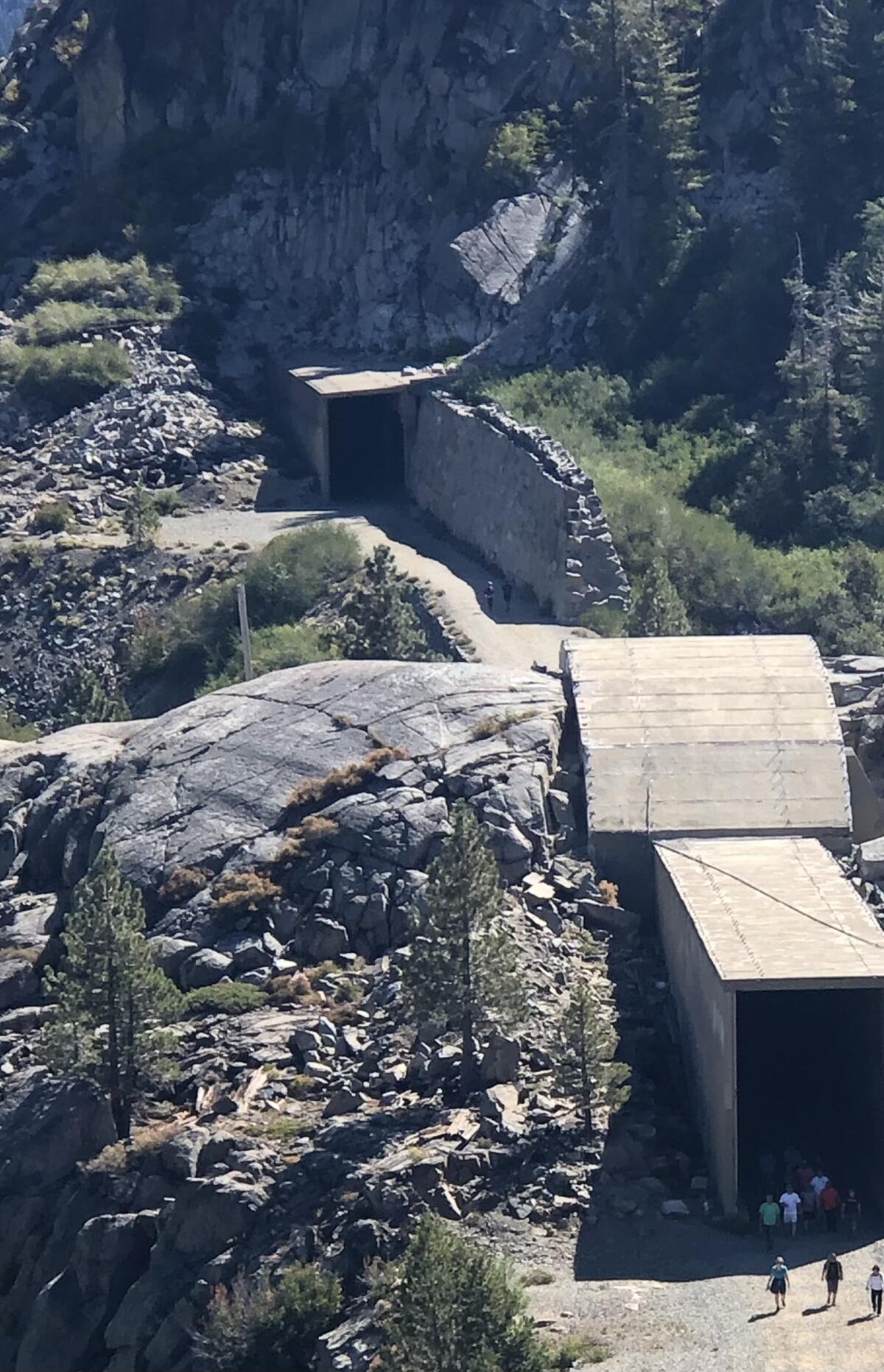Calculating the fallout from the streaming wars

- Share via
Good morning, and welcome to the Essential California newsletter. It’s Monday, June 19. I’m Matt Brennan, The Times’ deputy editor for entertainment and arts.
Today marks 48 days into the first Hollywood writers’ strike of the streaming era, and by many accounts, the picture is bleak.
The already dim hope of a swift resolution between the Writers Guild of America and the Alliance of Motion Picture and Television Producers has flickered out, and SAG-AFTRA, which represents actors, has authorized its own strike. (The Directors Guild this month agreed to a new three-year contract.)
The sticking points, on a granular level, are the state of residuals income, the rise of “mini-rooms” and fears of displacement by artificial intelligence, among other issues. More broadly, though, the conflict is over the very nature of the streaming revolution, which has in the last decade-plus upended film and TV as dramatically as color photography in the 1950s or the introduction of sound two decades earlier.
Led by Netflix, that revolution has come to inflect — or infect, depending on who you ask — nearly every aspect of the industry.
What we watch, when we watch, where we watch, even how we watch has changed significantly, fueled and shaped by technological advancements, the rise of social media platforms, the proliferation of TV programming, the COVID-19 pandemic and the fragmentation of the culture itself.
So has the measurement of success, the price of attracting top talent and the rhythms of work for Hollywood’s rank-and-file. Streamers have become major players at the Emmys and the Oscars and in the world of stand-up comedy; they’ve shaken — though not yet sunk — the theatrical exhibition of movies; they’ve created the expectation of an entire universe of films and TV series at our fingertips at little to no cost.
It’s no surprise that such a swift, seismic transformation should result in heartburn, or worse. The studios claim that streaming has squeezed their bottom line. Workers claim that streaming has made a middle-class existence in the business all but impossible, while pointing out that executives are doing just fine. And, as in any revolution, blowing up the old paradigm creates a state of chaos.
[Sign up for Screen Gab to get everything about the TV shows and streaming movies everyone’s talking about, in your inbox every Friday.]
That’s not to say the clouds amassed over the industry don’t have silver linings. With an assist from boutique streamers like Criterion Collection, Mubi and Kanopy — available for free with L.A. Public Library membership — international, art house and classic cinema is more widely accessible than at any point in history, especially for those of us who grew up trawling the stacks at Blockbuster in between show times at the suburban multiplex.
Streaming has also broken down one of the most intransigent barriers in American television — subtitles — turning series like “Call My Agent” and “Squid Game” into water-cooler hits and sparking the expansion of dedicated Spanish-only streaming brands targeted at bilingual families.
As the power struggle set off by the streaming revolution continues to play out, it shouldn’t be forgotten that we’ve been here before.
The history of Hollywood is, if nothing else, a 100 Years’ War between corporate interests and creative instincts, and that pitched battle, for all its lamentable casualties, has produced the most influential cultural economy on Earth. Understanding such ferment means acknowledging the tectonic forces that lie beneath the topical concerns of the current walkout, like algorithms and A.I.
“Not half a dozen men have been able to keep the whole equation of pictures in their heads,” F. Scott Fitzgerald famously wrote in his unfinished novel “The Last Tycoon.” If Hollywood’s first century can teach us anything as we enter its second, it’s that there’s no such thing as predicting the future — only adapting to it.
Anyone who tells you otherwise is selling you something, or lying.
We dig into this and more in a new project from The Times: the Ultimate Guide to Streaming. Read it here.
And now, here’s what’s happening across California, from Ryan Fonseca:
Note: Some of the sites we link to may limit the number of stories you can access without subscribing.
L.A. STORIES
After Texas officials bused 42 migrants to L.A., local aid groups and everyday Angelenos mobilized to help them. Latinos who spoke with The Times expressed sympathy and solidarity for the migrants, with one calling their safe arrival “a blessing.” Los Angeles Times
A group of South L.A.community members are demanding that Curren Price resign from the City Council. The District 9 representative faces 10 counts of embezzlement, perjury and conflict of interest, as prosecutors allege he voted on development projects in which he had a financial stake. Los Angeles Times
POLITICS AND GOVERNMENT
House Speaker Kevin McCarthy left his home turf of Bakersfield to meet with GOP colleagues in Orange County. Their discussion highlighted home-invasion burglaries allegedly committed by Chilean crime rings and demonstrated the Republican Party’s focus on immigration and public safety as key issues heading into the 2024 election. Los Angeles Times
Advocates and lawmakers seeking to strengthen abortion rights in California are eying “crisis pregnancy centers” as the next battleground. The centers have been accused of misleading pregnant people, but regulation has been a challenge. CalMatters
CRIME, COURTS AND POLICING
Last week, the U.S. Supreme Court ruled to uphold the Indian Child Welfare Act, which keeps Indigenous children from being removed from their tribal communities and placed in non-Native foster care or adoptive homes. Tribal leaders in Southern California expressed relief at the decision, saying the law is key to tribal sovereignty. San Diego Union-Tribune
L.A. County and the American Civil Liberties Union have reached a settlement to improve county jails. The agreement focused on conditions at the Inmate Reception Center in downtown L.A., which an ACLU attorney described as “barbaric.” LAist
Support our journalism
HEALTH AND THE ENVIRONMENT
In late April, the California Air Resources Board approved a landmark set of rules to phase out diesel-fueled locomotives from operating in the state. That didn’t sit well with the railroad industry, which last week filed a federal lawsuit, arguing that the California regulators don’t have the authority to set standards for companies operating across multiple state lines. Associated Press
TIL that bald eagles sometimes adopt — or chicknap — baby red-tailed hawks. Bay Area birdwatchers witnessed an eagle couple do that last month, and now one hawk chick appears poised to leave its foster nest. San Francisco Chronicle
CALIFORNIA CULTURE
Surfing in the U.S. has long been dominated by white men. But Black and Hispanic surfers are on the rise, according to industry reports — and some brands are taking steps to promote inclusion. Orange County Register
Bottles of beloved Sriracha hot sauce are a hot-ticket item in California amid an ongoing production shortage. At least one Bay Area grocery is charging nearly $30 a bottle, while the sauce is reportedly being stolen from one restaurant chain. SFGATE
Free online games
Get our free daily crossword puzzle, sudoku, word search and arcade games in our new game center at latimes.com/games.
AND FINALLY
Today’s California landmark is from David Hatoff of San Clemente: Donner Summit, the “portal to California from the east.”

David writes:
The trading trail of Native Americans was widened to accommodate wagons of the 19th century before being incorporated into the Lincoln Highway by 1913. Bulling straight over this small pass, the original transcontinental railroad passed through snow sheds and solid granite. Now, 21st century day hikers are seen sharing this historic gap in the Sierras.
What are California’s essential landmarks? Fill out this form to send us your photos of a special spot in California — natural or human-made. Tell us why it’s interesting and what makes it a symbol of life in the Golden State. Please be sure to include only photos taken directly by you. Your submission could be featured in a future edition of the newsletter.
Please let us know what we can do to make this newsletter more useful to you. Send comments to [email protected].
Sign up for Essential California
The most important California stories and recommendations in your inbox every morning.
You may occasionally receive promotional content from the Los Angeles Times.




